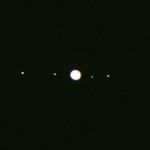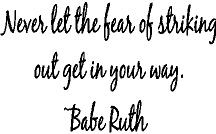I bought my daughter a telescope for Christmas. It’s a 70mm refraction telescope with a 9x and 25x eyepieces. I confess I’d been hankering for something bigger, maybe in the 4-6 inch reflecting range, but they were much pricier, and all the reviews pointed to this as an excellent starter telescope. I also knew it was powerful enough to see Saturn’s rings.
So, we put it together, confirmed that the red-dot viewfinder was properly aligned, and waited for a clear night. And waited. And waited. That last week of December was pretty cloudy here in central Texas, but it did clear eventually, so we grabbed the telescope and headed out into the frigid night — well, at least as cold as it gets in this part of Texas, i.e. about 25F.
I had not done any preparation or research. I had no plan of observation. I had no star charts. Even the little star-map app on my phone was a bust since my phone is pretty poor at detecting its own orientation. But I figured we could just go out, point the telescope at some light in the night sky, and see what it was, a bit like those astronomers of the early 1600’s. Even with me living somewhat out in the country, they probably had much less light pollution than I did, but the quality of my optics were vastly better than theirs.
First of all, with 70mm of light-gathering aperture, the moon is way too bright to look at. Seriously. It wasn’t quite “do not look at moon with remaining eye, but I could see the moonlight blasting out of the eyepiece, illuminating dust particles. So, I gave up on any direct moon observations until we could add some kind of dark moonlight-filter to the setup.
Then I pointed it at some bright light about 20 degrees above the horizon. I used the viewfinder to line it up, then peered through the eyepiece only to find it empty. I looked through the viewfinder again to see that I was off target. I figured I must have bumped it, so I lined it up again, went to look, and damn, still nothing there. By the time I went to line it up again, I could actually see the thing moving. It was an airplane.
By this point, my nine-year-old daughter’s excitement is turning to impatience. It was literally — yes, literally — freezing out there, and all she had gotten for her troubles so far was to watch me play with her Christmas present.
I looked up at the sky, trying to find something interesting. I saw the constellation of Orion, and remembered something vague about how one of the stars in Orion’s belt was actually a nebula, or maybe a galaxy. Or was that in the sword hanging down from the belt? My daughter started pacing to stay warm.
A little bit up north from Orion, however, was a particularly bright light. I knew my compass directions well enough to know it wasn’t Polaris, so I figured there was a decent chance it was a planet. Given how far it was from the now-set sun, I knew it couldn’t be Mercury or Venus, and its color did not make me think of the red Martial soil at all. I didn’t think Uranus or Neptune could be seen with the naked eye, so I figured it was Jupiter or Saturn. Either one should make for an interesting peek.
So I pointed the telescope up, got down on the concrete of the driveway and peered through the viewfinder. I got the red-dot lined up on the bright light and took a look through the eyepiece.
For the first time, I was rewarded with not a blank field or some blinding moon. It wasn’t even a point anymore. It was a circle. It wasn’t a giant disk with swirling clouds and a big red dot, but it was clearly a circle. There were no rings, either, but this was clearly a planet, not some distant star.
I fine-tuned the position controls to center it, and handed it over to my daughter. “I think that’s Jupiter,” I told her.
 She looked through it and waved her arms in excitement. I told her to be careful not to bump the telescope, and she calmed down and peered some more. Eventually she stood, looked back up at the point in the sky and asked, “What are those dots next to it?”
She looked through it and waved her arms in excitement. I told her to be careful not to bump the telescope, and she calmed down and peered some more. Eventually she stood, looked back up at the point in the sky and asked, “What are those dots next to it?”
I looked up and only saw a scattering of other stars. “What dots?”
“In the telescope,” she said. “There are dots next to Jupiter.”
So I sat down on the ground and looked in the eyepiece again. Sure enough, there were four dots around Jupiter, two on each side, evenly spaced. I realized I had noticed them before but dismissed them as some optical artifact between the telescope lenses and my contact lenses. The spacing and arrangement was just too regular to be anything else. Or maybe I’ve just seen too many lens flare effects in recent Sci-Fi movies.
But no matter how much I blinked, the dots did not go away. Eventually they started drifting up out of the view as the Earth rotated, so I used the fine-tuning controls to bring them back into view. They were still there. I angled my head one way and another, but no matter what I did, they remained persistently visible and kept themselves aligned the same way.
That’s when it hit me. These were not optical artifacts. These were the four big moons of Jupiter: Io, Europa, Ganymede, and Callisto.
“They’re moons,” I told her. “Those are four of Jupiter’s moons.”
“Jupiter has moons?” she asked incredulously.
“Yes,” I told her all proud of passing on this knowledge, but then I realized that she was the one who had spotted them, not me. I had dismissed them as tricks of the light, but she had noticed them and wanted to know what they were. “They’re the four biggest moons of Jupiter, and you just discovered them.”
She looked back through the telescope again solemnly. “Moons… cool.”
 Since then, we’ve talked about how Galileo first saw them through his telescope just over 400 years ago. We’ve gone looking since, and seen them with different spacing, including seeing only three, figuring that one was either in front of or behind Jupiter. I’m trying to explain to her how you can discern that these different observations allowed Galileo to discern that they were circling Jupiter. The theological and political implications of that in what was then still officially an Earth-centered universe will have to wait until she’s a little older.
Since then, we’ve talked about how Galileo first saw them through his telescope just over 400 years ago. We’ve gone looking since, and seen them with different spacing, including seeing only three, figuring that one was either in front of or behind Jupiter. I’m trying to explain to her how you can discern that these different observations allowed Galileo to discern that they were circling Jupiter. The theological and political implications of that in what was then still officially an Earth-centered universe will have to wait until she’s a little older.
It’s easy for us to think of those early astronomers like Galileo as epic figures, locked in a struggle against the stratified philosophies of the universe. Yet, at the heart of it, he was just a curious fellow who asked the same question my little girl just asked. “Just what are those dots next to Jupiter?”


 The first valuable thing that comes from doing it wrong the first time is that you’ve actually done it the first time. I can’t tell you how many people I hear talking about the things they want to do someday, as soon as they can take the time to learn how. They’re not actually going to try it out, sign up for lessons, or even pick up the necessary tools, but “someday”, they’re going to learn it.
The first valuable thing that comes from doing it wrong the first time is that you’ve actually done it the first time. I can’t tell you how many people I hear talking about the things they want to do someday, as soon as they can take the time to learn how. They’re not actually going to try it out, sign up for lessons, or even pick up the necessary tools, but “someday”, they’re going to learn it. Style? Where did that come from? It turns out that’s the other valuable thing that comes from doing it wrong. Some folks say you should study the styles of the masters: Babe Ruth, Benny Goodman, William Faulkner. While there’s nothing wrong with checking them out, the simple fact is that you’re not them. And more to point, they are not you. Their style might not work for your body, your brain, or your kind of story.
Style? Where did that come from? It turns out that’s the other valuable thing that comes from doing it wrong. Some folks say you should study the styles of the masters: Babe Ruth, Benny Goodman, William Faulkner. While there’s nothing wrong with checking them out, the simple fact is that you’re not them. And more to point, they are not you. Their style might not work for your body, your brain, or your kind of story.